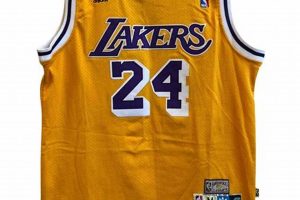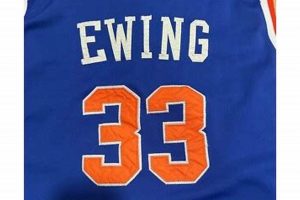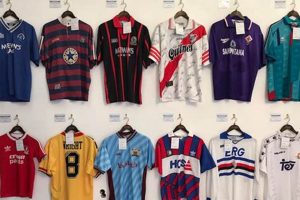Garments previously worn by players or officially produced for fans that represent Manchester United from past eras are highly sought after. These items often evoke a sense of nostalgia and represent specific periods in the clubs history, player associations, and iconic designs. For example, a green and gold Newton Heath jersey or the cantona collar up jersey can represent these jerseys.
These items hold value beyond their functional use as clothing. They function as tangible connections to the club’s legacy, significant victories, and legendary players. The collectibility of these items is driven by their rarity, historical significance, and the emotional connection fans have with the team’s past. Owning a piece of this sporting history allows individuals to preserve and display a symbol of pride.
The following sections will delve deeper into key aspects of these historically significant football shirts, including factors influencing their value, how to identify authentic examples, and notable designs throughout the club’s history.
Tips for Acquiring Vintage Manchester United Jerseys
The purchase of football shirts requires careful consideration to ensure authenticity, value, and personal satisfaction. The following are crucial points for prospective buyers.
Tip 1: Authenticate the Item: Thoroughly examine the item for manufacturer details, including logos, tags, and stitching quality. Research known characteristics of official merchandise from the period the shirt represents. Compare these details to images and information from reputable sources dedicated to item authentication.
Tip 2: Assess Condition Carefully: The item’s overall state significantly impacts its value. Examine the material for signs of wear, such as stains, pulls, fading, or damage to the crest or sponsor logos. Note that while some wear is expected in vintage items, excessive damage can significantly diminish value.
Tip 3: Investigate the Source: Acquire these items from trusted sources, such as established vintage sports memorabilia dealers, reputable auction houses, or collectors with verifiable histories. Exercise caution when purchasing from unknown or unverified sources.
Tip 4: Research Market Value: Before making a purchase, research the current market value of similar items in comparable condition. Consult auction records, online marketplaces, and dealer inventories to establish a reasonable price range.
Tip 5: Consider Player Association: Items worn or signed by prominent players from the club’s history often command a premium. Verify any claims of player association through authentication services specializing in sports memorabilia.
Tip 6: Preserve with care: The preservation of the jersey is important to retain or increase the jersey’s worth. Methods such as framing and avoiding direct sunlight should be implemented for better preservation
Applying these tips ensures a more informed and secure purchasing experience, minimizing the risk of acquiring counterfeit or misrepresented items.
The subsequent section will offer further insights into the specific historical context and design evolution of these sought-after shirts.
1. Authenticity
Establishing genuineness is paramount when acquiring football shirts. It ensures the item is an officially produced piece of memorabilia, possessing the intrinsic value associated with officially licensed merchandise.
- Manufacturer’s Markings
Official shirts from past eras bear specific manufacturer markings, including logos, care labels, and sizing information. Comparing these markings to known standards for a given period is a crucial step. Examples include the presence of the Umbro logo on shirts from the 1990s or the Adidas logo on more recent models. Variations or omissions may indicate a reproduction.
- Fabric and Construction
The type of fabric and construction techniques employed in the shirt’s production are indicators of authenticity. Official merchandise typically uses high-quality materials and precise stitching. Examining the texture, weight, and weave of the fabric, as well as the quality of the seams and embroidery, can reveal discrepancies.
- Sponsor Logos and Crests
Sponsor logos and club crests should be consistent with those used during the specific season the shirt represents. Variations in font, color, placement, or stitching of these elements can suggest a lack of authenticity. For instance, examining the Sharp logo font used in the 1990s. Any deviation from this official logo raises concern.
- Tags and Labels
Official shirts include tags and labels providing information about the manufacturer, materials, and care instructions. These tags should be securely attached and feature accurate information. Inconsistencies in the language used on the tags or the absence of expected information may indicate a reproduction.
Successfully verifying genuineness requires meticulous examination and comparison against reliable reference materials. This process safeguards against acquiring counterfeit items and ensures the collectible value remains intact.
2. Rarity
The scarcity of a specific shirt significantly elevates its desirability among collectors. Several factors contribute to a shirt’s limited availability, enhancing its appeal as a sought-after item.
- Limited Edition Releases
Certain shirts were produced in limited quantities, often to commemorate specific events, anniversaries, or partnerships. These releases inherently possess a higher degree of scarcity due to the restricted production numbers. For example, a shirt released to celebrate a specific trophy win with only a few thousand produced is highly desirable.
- Player-Issued Garments
Shirts issued to players for matches, especially those worn during significant games, represent a highly exclusive category. These garments are often distinct from commercially available versions, featuring unique specifications or modifications. Their direct association with a player and a specific event further enhances their rarity.
- Short Production Runs
Shirts produced for a single season or a brief period may become scarce over time due to discontinuation. Changes in manufacturers, sponsors, or designs can lead to limited availability of specific models. This is exemplified by a shirt design used only for a mid-season match, making it harder to find.
- Errors and Variations
Manufacturing errors or design variations, while unintentional, can create unique and rare shirts. These deviations from the standard design, such as misprinted logos or incorrect color schemes, make the affected shirts highly sought after by collectors seeking unusual items. An example would be a shirt with a sponsor logo printed upside down.
The convergence of these elements determines the ultimate scarcity of a specific shirt, thereby influencing its value within the market. Each of these points is factored into valuing a particular jersey.
3. Condition
The physical state directly influences the perceived value and collectibility of vintage Manchester United shirts. Degradation or preservation can significantly affect its worth, impacting desirability among collectors.
- Fabric Integrity
The fabric’s overall strength is paramount. Tears, holes, or significant weakening degrade its condition. Degradation is assessed by noting staining, fading, and discoloration. Examples include fading caused by direct sunlight or staining from storage, which diminishes visual appeal and structural integrity. Maintaining fabric integrity is important for the shirt to be considered a high-quality piece.
- Print and Embellishment Quality
Sponsor logos, player names/numbers, and club crests often adorn the fabric. The quality of these applications impacts the overall garment condition. Cracking or peeling detracts from the visual presentation. In addition, examine the quality of the stitching to see if it is pulling away from the jersey. For example, a cracked sponsor logo can greatly diminish the appeal of the jersey.
- Stitching and Seam Strength
The integrity of the stitching and seams is critical to the shirt’s structural integrity. Loose, frayed, or broken seams compromise the garment’s construction. Stressed areas, such as the shoulders and armholes, should be examined for wear. Damaged or poorly maintained seams directly reflect the shirt’s condition.
- Original Tags and Labels
The presence and condition of original tags and labels contribute to its authenticity. Intact and legible tags enhance provenance. Missing or damaged tags negatively impact authenticity and value. Original tags give insight into the history of the garment, thus increasing its quality.
Considering these elements provides a complete assessment of a shirt’s physical state, thus impacting its desirability and market value. Preservation of these shirts is important to maintain historical condition and worth.
4. Historical Significance
A football shirt from Manchester United’s past transcends its function as mere apparel. It embodies specific moments, eras, and narratives that shape the club’s identity and legacy. The historical context imbues these garments with a value that extends beyond their material composition.
- Trophy-Winning Seasons
Shirts worn during seasons culminating in significant trophy victories, such as Premier League titles or Champions League triumphs, hold immense historical weight. These garments become tangible representations of success and are associated with the players and managers who achieved those milestones. For example, the shirt worn during the 1999 Champions League final resonates deeply with fans due to the dramatic nature of the victory and the players involved.
- Iconic Player Associations
Garments worn or associated with legendary players like George Best, Sir Bobby Charlton, Eric Cantona, or Cristiano Ronaldo gain historical significance due to their connection with these influential figures. Their presence on the pitch during specific eras transforms the shirt into a symbol of their contributions to the club’s heritage. A shirt bearing Cantona’s name and number carries the weight of his impact on the team’s attacking prowess and charismatic persona.
- Commemorative Designs
Shirts designed to commemorate anniversaries, special events, or historical milestones inherently possess significance. These designs often incorporate unique elements that reflect the occasion, making them distinct from regular season attire. The shirt worn during the club’s centenary year, for instance, represents a tangible link to its founding and evolution over time.
- Kit Evolution and Fashion Trends
The evolution of kit designs reflects changing fashion trends and cultural influences. Each design represents a specific period in the club’s history and evokes memories of the era. The transition from heavier cotton materials to lightweight synthetics, or the adoption of bold graphic patterns, mirrors broader societal changes and adds another layer of historical context.
These interconnected elements of historical context, trophy wins to player associations and evolving styles, establish the importance of a shirt’s value and its status as a sought-after item among collectors and fans alike. They provide a tangible connection to Manchester United’s rich and storied past.
5. Player Association
The link between a specific player and a garment from Manchester United’s past holds immense significance in determining its collectability and market value. The player’s impact, tenure, and achievements while wearing that design contribute substantially to its desirability among fans and collectors. This association elevates the piece beyond a mere article of clothing, transforming it into a tangible link to a celebrated figure.
- Signed Memorabilia
A shirt bearing the authentic signature of a prominent player greatly enhances its value. The signature serves as direct confirmation of the player’s connection to the garment, solidifying its provenance and increasing its appeal to collectors. Verification of the signature’s authenticity is essential to ensure its legitimacy.
- Match-Worn Garments
Shirts worn by players during official matches, especially those from significant games or seasons, represent the pinnacle of player association. These garments often feature unique characteristics, such as alterations tailored to the player’s specifications or visible signs of wear, that further authenticate their provenance. Documented provenance is crucial in establishing the item’s legitimacy and historical context.
- Era-Defining Figures
The historical importance of the player wearing the shirt significantly impacts its value. A shirt associated with a player who defined an era, such as George Best, Eric Cantona, or Cristiano Ronaldo, carries a greater weight due to their profound influence on the club’s history and their iconic status among fans.
- Limited Edition Player Releases
Some shirts are released in limited quantities featuring a specific player’s name and number. These releases, often created to commemorate a milestone or achievement, are inherently more valuable due to their scarcity and direct association with the player. The limited nature of these releases drives up their desirability among collectors seeking unique pieces of memorabilia.
In conclusion, the association with a player through signed memorabilia, match-worn status, or historical significance greatly enriches these garments from Manchester United’s past. Each component, when carefully authenticated and contextualized, transforms the shirt into a tangible piece of the club’s history and a lasting connection to the players who shaped its legacy.
Frequently Asked Questions
The following section addresses common inquiries regarding the acquisition, valuation, and authentication of Manchester United garments from past eras, offering insights for collectors and enthusiasts.
Question 1: How does the age of a garment influence its value?
Generally, older garments tend to possess a higher market value, particularly if they are associated with significant historical periods or events. However, condition, rarity, and player association also play crucial roles in determining overall worth.
Question 2: What are the most common indicators of a counterfeit shirt?
Discrepancies in manufacturer logos, incorrect font usage, poor stitching quality, and missing tags are all warning signs. Comparing the garment to known authentic examples is crucial for identification.
Question 3: How can the authenticity of a signature on a garment be verified?
Submitting the item to a reputable authentication service specializing in sports memorabilia is advisable. These services utilize expert analysis and databases to confirm the legitimacy of signatures.
Question 4: What is the best method for preserving vintage shirts?
Storing the garment in a climate-controlled environment away from direct sunlight is recommended. Archival-quality storage materials can further protect the fabric from deterioration.
Question 5: Does a shirt’s size impact its collectibility?
Yes, rarer sizes, particularly those worn by prominent players, may command a premium. Common sizes generally hold less value, unless other factors, such as match-worn status, are present.
Question 6: Where are the most reputable sources for acquiring vintage shirts?
Established sports memorabilia dealers, reputable auction houses, and collectors with verifiable histories are the most reliable sources. Exercising caution when purchasing from unknown or unverified vendors is crucial.
Accurate information and careful analysis are essential for navigating the world of collectible Manchester United shirts. Authentication is crucial.
The next section will provide resources to further aid the authentication of these garments.
Conclusion
The exploration of the realm surrounding the vintage manchester united jersey reveals a complex interplay of history, artistry, and passion. These garments transcend their utility as sportswear, embodying specific moments in the club’s narrative and serving as tangible links to legendary players and iconic triumphs. Accurate assessment of authenticity, condition, rarity, and historical association is required to discern true value within this market.
The enduring allure of the vintage manchester united jersey underscores its role as a cultural artifact, preserving the legacy of a storied football club. Further research and careful evaluation are vital for collectors and enthusiasts seeking to acquire and safeguard these pieces of sporting history for future generations. Diligence ensures these historic items remain a tribute to the club’s lasting impact.







